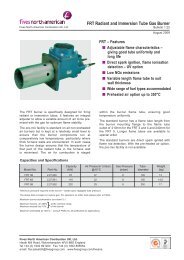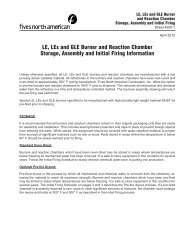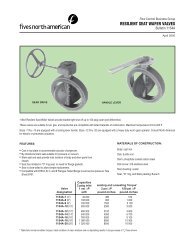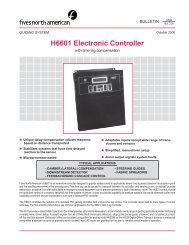Positioner for 1600 DIAPHRAGM AIR MOTORS - Fives North ...
Positioner for 1600 DIAPHRAGM AIR MOTORS - Fives North ...
Positioner for 1600 DIAPHRAGM AIR MOTORS - Fives North ...
Create successful ePaper yourself
Turn your PDF publications into a flip-book with our unique Google optimized e-Paper software.
Valve positioners employ the full <strong>for</strong>ce of their air supply to drive the piston<br />
or diaphragm in a pneumatic actuator to the position called <strong>for</strong> by a control<br />
instrument-and to hold that position, regardless of the <strong>for</strong>ces which tend<br />
to change valve position.<br />
Each positioner receives a signal from a control instrument; and using<br />
an air supply as high as 100 psig, the built-in valve positioner strokes the<br />
valve actuator to the required position. (For more-detailed in<strong>for</strong>mation on<br />
operation, see the appropriate side of this page.)<br />
Like all valve positioners, the R620-2101 has a feedback circuit which<br />
measures the position of the actuator's piston or diaphragm. The built-in<br />
valve positioner supplies or exhausts air to make the actuator obey the<br />
control-instrument signal.<br />
The positioner is a pneumatic booster. It requires 26-30 psi clean supply<br />
air, which it applies directly to the motor.<br />
The motor is set to go from fully closed to fully open with a range of 7-19<br />
psi. Control instrument signals are the same 3-15 psi as when operating<br />
without a positioner, but the positioner boosts them to as much as 30 psi<br />
to the motor, thereby increasing motor torque and assuring appropriate<br />
control motor response.<br />
Input Range: 3-15, 3-9, 9-15, 3-27, 6-30 psig<br />
Valve Travel: Minimum 1 / 4 "<br />
Maximum 4"<br />
Supply Pressure: Minimum 3 psi above required<br />
actuator pressure<br />
Maximum 50 psig<br />
SPECIFICATIONS<br />
Flow Control Business Group<br />
<strong>Positioner</strong> <strong>for</strong><br />
<strong>1600</strong> <strong>DIAPHRAGM</strong> <strong>AIR</strong> <strong>MOTORS</strong><br />
Bulletin <strong>1600</strong>-P<br />
December 1999<br />
The positioner also allows customizing of the span to match various controllers.<br />
The standard full travel span of 12 psi (3-15 psi control signal) can<br />
be altered by changing the spring in the positioner. Springs are available<br />
to yield 3, 4, 5, 6, 8, 10, or 24 psi spans. See Parts List <strong>1600</strong>-1 <strong>for</strong> spring<br />
part numbers.<br />
Interchangeable Range Springs<br />
The position of the piston or diaphragm in the valve actuator is sensed by<br />
the amount of compressive <strong>for</strong>ce exerted by a range spring on the valve<br />
positioner's diaphragm assembly. By selecting the appropriate range spring,<br />
from a wide selection which is available, almost any combination span (from<br />
2 to 24 psi) may be obtained.<br />
Materials of Construction<br />
Aluminum, brass, stainless steel, neoprene and/or Buna-N.<br />
Air Consumption: 73N-F 0.25 scfm<br />
(in balance condition with 73N-B 0.6 scfm<br />
20 psig supply and 9 psig<br />
dead-ended output).<br />
Overrange Limit: 150 psig to any connection<br />
Response Level: 0.1% of input span<br />
(Output sensitivity to input<br />
pressure changes)
FIVES NORTH AMERICAN COMBUSTION, INC. Bulletin <strong>1600</strong>-P, 12-99<br />
Page 2<br />
Top-Loading, Direct-Acting<br />
Air pressure from the control instrument (indicated as dark gray in the above schematic drawing) is exerted between the two lower diaphragms. Because<br />
of the difference in diaphragm areas, the resultant <strong>for</strong>ce is exerted in an upward direction. In a balanced condition, the pneumatic <strong>for</strong>ce on the diaphragm<br />
assembly-plus the upward <strong>for</strong>ce exerted by the range spring-will be balanced by the downward <strong>for</strong>ce of the zero-adjustment spring.<br />
When control-instrument pressure increases, the diaphragm assembly will move upward and the pilot valve will be moved upward; closing the exhaust port<br />
and opening the supply port to admit supply air directly to the actuator. The supply air will drive the actuator downward. As the actuator moves down, the<br />
range spring will relax until its <strong>for</strong>ce decreases enough to offset the increase in control-instrument pressure.<br />
Suppression spring<br />
Supply air<br />
Atmospheric vent<br />
Valve-actuating pressure<br />
Diaphragms<br />
Zero adjustment<br />
Pilot valve<br />
Control-instrument air pressure<br />
Exhaust<br />
Range spring<br />
Supply pressure<br />
Control-adjustment air pressure<br />
Valve-actuating pressure<br />
WARNING: Situations dangerous to personnel and property may exist with the operation and maintenance of an combustion equipment.The presence of fuels, oxidants, hot and cold<br />
combustion products, hot surfaces, electrical power in control and ignition circuits, etc.,are inherent with any combustion application. Parts of this product may exceed 160F in operation<br />
and present a contact hazard. <strong>Fives</strong> <strong>North</strong> American urges compliance with National Safety Standards and insurance Underwriters recommendations, and care in operation.<br />
<strong>Fives</strong> <strong>North</strong> Amercian Combustion, Inc., 4455 East 71st Street, Cleveland, OH 44105 USA, Phone 216.271.6000<br />
Fax 216.641.7852 email: fna.sales@fi vesgroup.com • www.fi vesgroup.com/fi vesna<br />
Printed in USA Supersedes Sheet <strong>1600</strong>-2<br />
FNA 7-00-B<strong>1600</strong>-P







